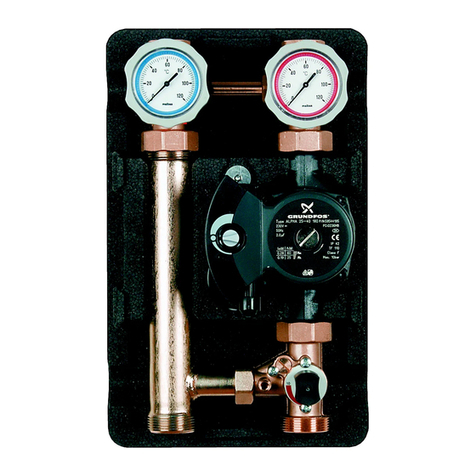
3
1. Grundlagen
1.1 Sicherheitshinweise
Bitte befolgen Sie diese Sicherheitshinweise genau, um Gefahren und Schäden für Menschen und Sachwerte auszuschließen. Die Monta-
ge, Erstinbetriebnahme, Inspektion, Wartung und Instandsetzung müssen von einer zugelassenen Fachfirma ausgeführt werden. Machen
Sie sich vor Arbeitsbeginn mit allen Teilen und deren Handhabung vertraut. Beachten Sie die gültigen Unfallverhütungsvorschriften,
Umweltvorschriften und gesetzlichen Regeln für die Montage, Installation und den Betrieb. Des weiteren die relevanten einschlägigen
Richtlinien der DIN, EN, DVGW, VDI und VDE sowie alle aktuellen relevanten länderspezifischen Normen, Gesetze und Richtlinien.
Arbeiten an der Anlage: Anlage spannungsfrei schalten und auf Spannungsfreiheit kontrollieren (z.B. an der separaten Sicherung
oder einem Hauptschalter). Anlage gegen Wiedereinschalten sichern. (Bei Brennstoff Gas den Gasabsperrhahn schließen und gegen
unbeabsichtigtes Öffnen sichern). Instandsetzungsarbeiten an Bauteilen mit Sicherheitstechnischer Funktion sind unzulässig. Der
Montageort muss trocken und frostsicher sein. Gefährdungen durch angrenzende Bauteile sind zu vermeiden. Der freie Zugang muss
sichergestellt sein.
1.2 Bestimmungsgemäßer Einsatz
Die in der nachfolgenden Anleitung benannten Bauteile sind für den Einsatz in Heizungsanlagen nach DIN EN 12828 bestimmt. Der Betrieb
mit verunreinigtem Wärmeträger ist unzulässig-dazu zählen u.a. Fremdpartikel, härtebildendende Stoffe und Sauerstoff. Die Stromversor-
gung der Umwälzpumpe wird bedarfsorientiert von einer externen Regelung übernommen – ebenso bei Bedarf die Ansteuerung für die
Drehzahlregelung. Ein Rückflussverhinderer, meist in einen Kugelhahn integriert und manuell aufstellbar, sperrt die Strömung entgegen der
gewollten Richtung. Der Auslieferungszustand umfasst Material für die Integration in Systeme mit passendem Verteiler. Zubehör ermöglicht
den Einsatz als Einzelkomponente
Pumpengruppen UK, UK-Z
Die Pumpengruppen UK und UK-Z sind konzipiert, Heizungswasser in ungemischten Heizkreisen umzuwälzen. Typische Anwendungen fin-
den sich bei Radiatorenheizung und Speicherladung.
Pumpengruppen MK, MK-Z
Die Pumpengruppen MK und MK-Z sind konzipiert, Heizungswasser in gemischten Heizkreisen umzuwälzen. Typische Anwendungen finden
sich bei Fußboden- und Wandheizungen. Ein Stellantrieb für den Mischer ist als Zubehör in verschiedenen Varianten zu ergänzen.
Konstantwertregelset
Einsatz wie MK, aber mit vormontiertem Stellantrieb mit Festwertregelung. Typische Anwendungen finden sich bei Heizsystem mit Tempe-
raturbegrenzung zum Schutz der Anlagenteile oder mit nachgeschalteter Regelung der bedarfsgerechten Wärmeversorgung.
Trennsystem
Einsatz wie UK, aber inklusive Plattenwärmetauscher zur hydraulischen Trennung des Heizkreises vom übrigen System. Absicherung gegen
Überdruck des separaten Heizkreises ist im Set enthalten. Die Umwälzpumpe ist korrosionsresistent. Typische Anwendungen finden sich
bei Heizkreisen mit diffusionsoffenem Kunststoffrohr (ältere Fußbodenheizungen) oder mit besonderem Wärmeträger (z.B. Frostschutz) oder
mit anderem Anlagendruck.
DE
























